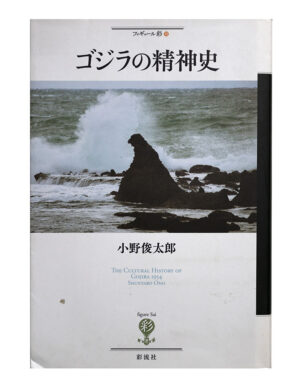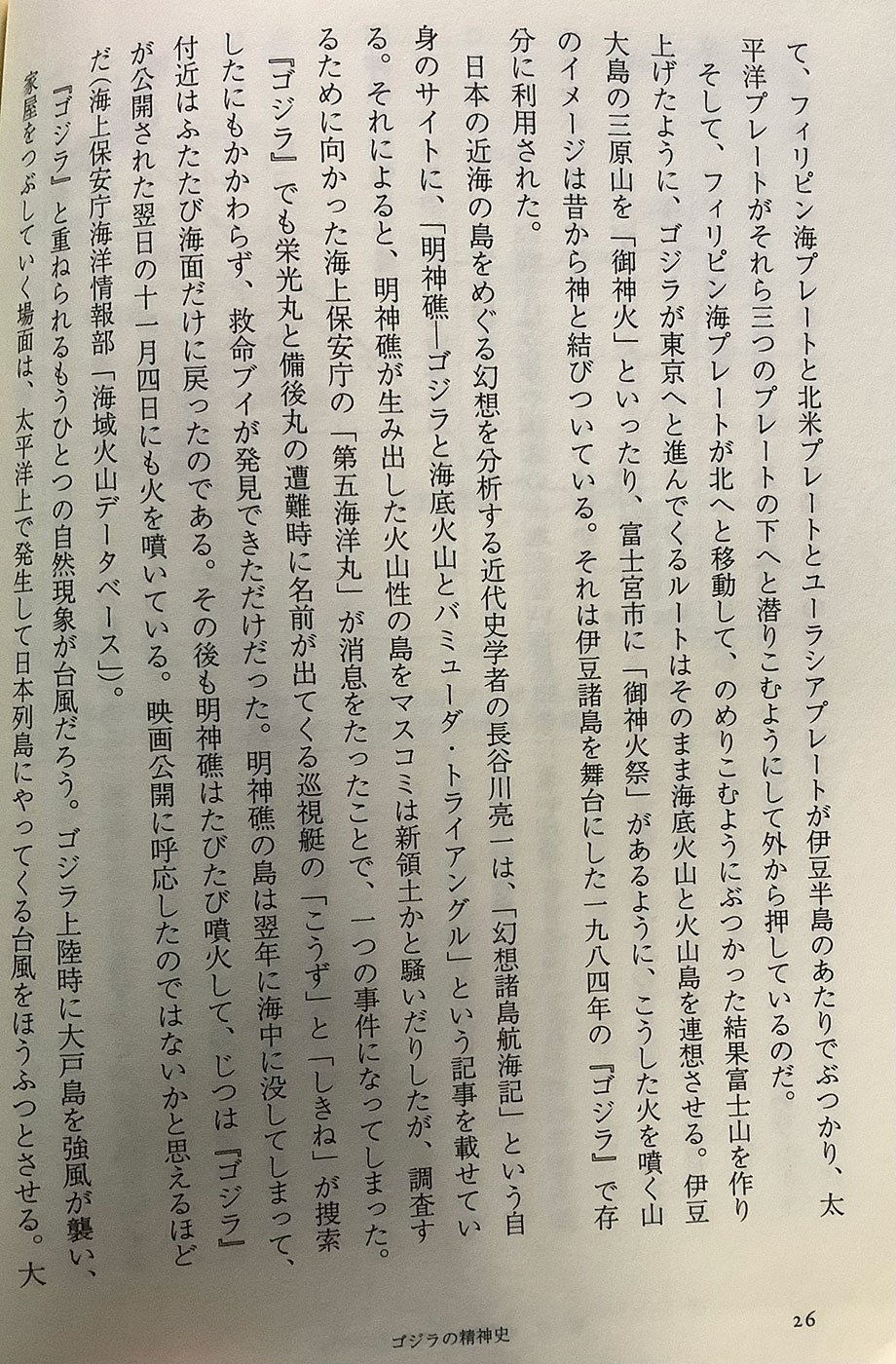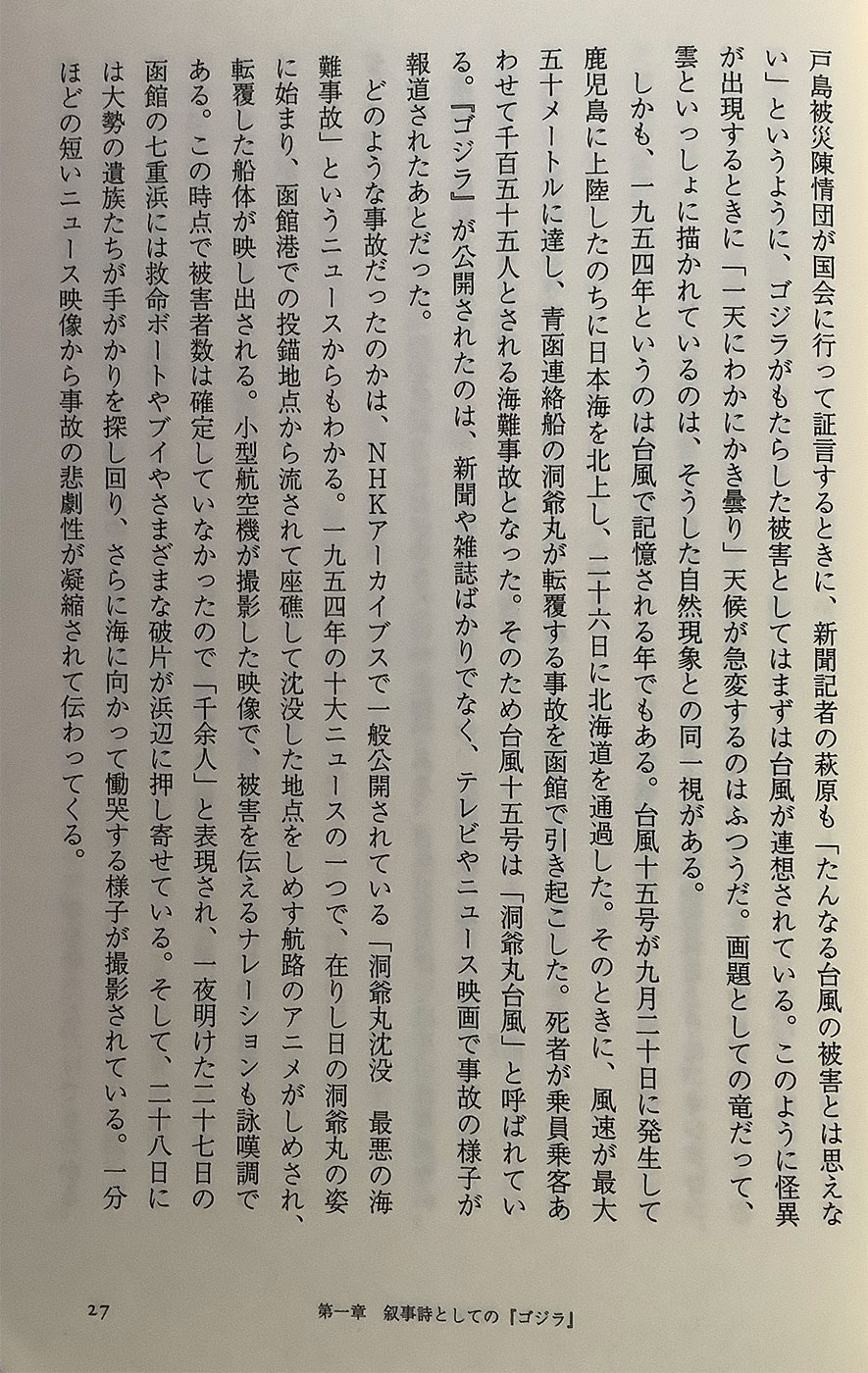9.26.2022
The Cultural History of Godzilla – Pt 10


P 26
二〇一一年の東日本大震災以降、日本の海底地形について詳しくなった私たちは、海底のプレート状況が頭に入るようになった。日本列島そのものが、四つのプレートのせめぎ合いから形成されていて、フィリピン海プレートと北米プレートとユーラシアプレートが伊豆半島のあたりでぶつかり、太平洋プレートがそれら三つのプレートの下へと潜りこむようにして外から押しているのだ。
Since the Great East Japan Earthquake in 2011, we have become more familiar with the topography of the Japanese seafloor, and the state of the seafloor plates has come to our minds. The Japanese archipelago itself is made up of four clashing plates. The Philippine Sea plate, the North American plate, and the Eurasian plate collide around the Izu peninsula, and the Pacific plate is pushing from the outside as if it were going under those three plates.
そして、フィリピン海プレートが北へと移動して、のめりこむようにぶつかった結果富士山を作り上げたように、ゴジラが東京へと進んでくるルートはそのまま海底火山と火山島を連想させる。伊豆大島の三原山を「御神火」といったり、富士宮市に「御神火祭」があるように、こうした火を噴く山のイメージは昔から神と結びついている。それは伊豆諸島を舞台にした一九八四年の『ゴジラ』で存分に利用された。
And just as the Philippine Sea Plate moved northward and created Mt. Fuji as a result of its smashing collision, Godzilla’s route to Tokyo is directly reminiscent of submarine volcanoes and volcanic islands. The image of a fire-breathing mountain has been associated with gods since ancient times, as seen in the fact that Mt. Mihara on Izu Oshima is referred to as “gojinka” and the city of Fujinomiya has a “gojinka festival.” It was fully utilized in 1984’s “Godzilla” set in the Izu Islands.
日本の近海の島をめぐる幻想を分析する近代史学者の長谷川亮一は、「幻想諸島航海記」という自身のサイトに、「明神礁ゴジラと海底火山とバミューダ・トライアングル」という記事を載せてい る。それによると、明神礁が生み出した火山性の島をマスコミは新領土かと騒いだりしたが、調査するために向かった海上保安庁の「第五海洋丸」が消息をたったことで、一つの事件になってしまった。
Ryoichi Hasegawa, a modern historian who analyzes the illusions surrounding islands in the waters near Japan, posted an article on his website called “Gensou Shougakuki” titled “Myojin Reef Godzilla, Undersea Volcanoes, and the Bermuda Triangle.” According to it, the mass media made a fuss about the volcanic island created by the Myojin Shoal as a new territory, it became an incident when the Japan Coast Guard’s “Kyoto Maru No. 5,” which was sent to investigate, was lost.
『ゴジラ』でも栄光丸と備後丸の遭難時に名前が出てくる巡視艇の「こうず」と「しきね」が捜索 したにもかかわらず、救命ブイが発見できただけだった。明神礁の島は翌年に海中に没してしまって、付近はふたたび海面だけに戻ったのである。その後も明神礁はたびたび噴火して、じつは「ゴジラ』が公開された翌日の十一月四日にも火を噴いている。映画公開に呼応したのではないかと思えるほどだ(海上保安庁海洋情報部「海域火山データベース」)。
Even though the patrol boats Kozu and Shikine, whose names appear in “Godzilla” when Eikomaru and Bingomaru were in distress, searched for them, they only found a life buoy. Myojin Reef Island sank into the sea the following year, and the surrounding area returned to the surface of the sea again. After that, Myojin Reef erupted again and again, and even on November 4th, the day after the release of “Godzilla,” it erupted (Japan Coast Guard Oceanographic Information Department “Marine Volcano Database”).

P 27
「ゴジラ」と重ねられるもうひとつの自然現象が台風だろう。ゴジラ上陸時に大戸島を強風が襲い、家屋をつぶしていく場面は、太平洋上で発生して日本列島にやってくる台風をほうふつとさせる。大戸島被災陳情団が国会に行って証言するときに、新聞記者の萩原も「たんなる台風の被害とは思えない」というように、ゴジラがもたらした被害としてはまずは台風が連想されている。このように怪異が出現するときに「一天にわかにかき曇り」天候が急変するのはふつうだ。画題としての竜だって、雲といっしょに描かれているのは、そうした自然現象との同一視がある。
Another natural phenomenon that is superimposed on “Godzilla” is the typhoon. When Godzilla makes landfall, strong winds hit Odo Island, destroying houses. When the Odo Island disaster petition group went to the Diet to testify, newspaper reporter Hagiwara also said, “I can’t believe it was just a typhoon damage.” It is common for the weather to change abruptly when such apparitions appear. Even the dragon as a theme is drawn together with clouds, and there is an identification with such a natural phenomenon.
しかも、一九五四年というのは台風で記憶される年でもある。台風十五号が九月二十日に発生して鹿児島に上陸したのちに日本海を北上し、二十六日に北海道を通過した。そのときに、風速が最大五十メートルに達し、青函連絡船の洞爺丸が転覆する事故を函館で引き起こした。死者が乗員乗客あわせて千百五十五人とされる海難事故となった。そのため台風十五号は「洞爺丸台風」と呼ばれている。『ゴジラ』が公開されたのは、新聞や雑誌ばかりでなく、テレビやニュース映画で事故の様子が報道されたあとだった。
Moreover, 1954 is also remembered for the typhoon. Typhoon No. 15 occurred on September 20th, landed in Kagoshima, then moved north across the Sea of Japan, and passed through Hokkaido on the 26th. At that time, the wind speed reached a maximum of 50 meters, causing an accident in Hakodate in which the Seikan Ferry Toyamaru capsized. It was a maritime accident in which 1155 people, including the crew and passengers, were killed. Therefore, Typhoon No. 15 is called “Toyamaru Typhoon.” “Godzilla” was released after the accident was reported not only in newspapers and magazines, but also on TV and newsreels.
どのような事故だったのかは、NHKアーカイブスで一般公開されている「洞爺丸沈没最悪の海「難事故」というニュースからもわかる。一九五四年の十大ニュースの一つで、在りし日の洞爺丸の姿に始まり、函館港での投錨地点から流されて座礁して沈没した地点をしめす航路のアニメがしめされ、転覆した船体が映し出される。小型航空機が撮影した映像で、被害を伝えるナレーションも詠嘆調である。この時点で被害者数は確定していなかったので「千余人」と表現され、一夜明けた二十七日の函館の七重浜には救命ボートやブイやさまざまな破片が浜辺に押し寄せている。そして、二十八日には大勢の遺族たちが手がかりを探し回り、さらに海に向かって慟哭する様子が撮影されている。一分ほどの短いニュース映像から事故の悲劇性が凝縮されて伝わってくる。
What kind of accident it was can be understood from the news “The worst sea accident in which the Toya Maru sank,” which is open to the public on NHK Archives. One of the 10 major news stories of 1954, starting with the appearance of Toya Maru in the past, animation of the route showing the point where it was washed away from the anchorage point in Hakodate Port, ran aground and sank, and capsized. The hull is projected. The video was taken by a small aircraft, and the narration that conveys the damage is also lamenting. At this point, the number of victims had not been determined, so it was expressed as “more than 1,000 people.” Lifeboats, buoys, and various debris washed up on Nanaehama in Hakodate on the 27th. On the 28th, a large number of bereaved families were filmed searching for clues and crying toward the sea. The tragedy of the accident is conveyed in a condensed form from a short news video of about one minute.